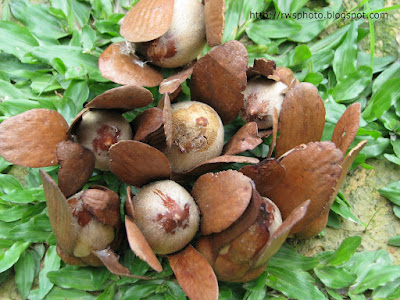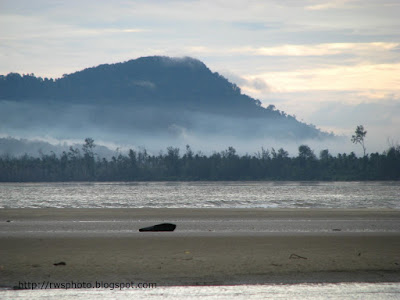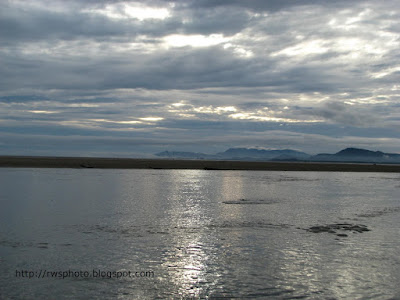Tropical Wild Mushroom, Fungi, Series 11
A tiny mushroom found on the jungle floor at Mt Singai, Bau.
 Recommended reading:
* Tiny Umbrella Mushrooms, Fungi, Series 10
* Orange cup mushroom, Fungi, Series 9
* Tropical orange mushroom, Fungi, Series 8
Recommended reading:
* Tiny Umbrella Mushrooms, Fungi, Series 10
* Orange cup mushroom, Fungi, Series 9
* Tropical orange mushroom, Fungi, Series 8
May 24, 2010
Bunga Misai Kuching - Orthosiphon stamineus
Orthosiphon stamineus or Misai Kucing (Malay for "Cat's Whiskers") is a traditional herb that is widely grown in tropical areas. The two general species, Orthosiphon stamineus "purple" and Orthosiphon stamineus "white" are traditionally used to treat diabetes, kidney and urinary disorders, high blood pressure and bone or muscular pain.
 Also known as Java tea, it was possibly introduced to the west in early 20th century. Misai Kucing is popularly consumed as a herbal tea. The brewing of Java tea is similar to that for other teas. It is soaked in hot boiling water for about three minutes, before being added with honey or milk. It can be easily prepared as garden tea from the dried leaves. There are quite a number of commercial products derived from Misai Kucing.
Also known as Java tea, it was possibly introduced to the west in early 20th century. Misai Kucing is popularly consumed as a herbal tea. The brewing of Java tea is similar to that for other teas. It is soaked in hot boiling water for about three minutes, before being added with honey or milk. It can be easily prepared as garden tea from the dried leaves. There are quite a number of commercial products derived from Misai Kucing.

Mar 22, 2010
Dimocarpus longan malesianus fruit bud
Up close photo of Dimocarpus longan malesianus fruit bud. The fruit bud is about the size of a matchstick head. Dimocarpus longan var. malesianus, locally known as Buah Mata Kuching, is a subspecies of longan that is better adapted to tropical conditions.
 Longan fruit is consumed fresh, dried, frozen and canned. Fresh fruit is consumed to reduce fevers, and the dried fruit as a cure for insomnia. Leaves contain quercetin, with antioxidant and antiviral properties, and are used in the treatment of allergies, cancer, diabetes and cardiovascular diseases. Crushed seeds produce foam, which is used as shampoo. The wood is used in the construction of furniture and other articles. The tree is also planted as an ornamental.
SEO: Euphoria longana, Euphoria longan, Nephelium longana, Nephelium longan, Buah Lengkeng, Buah Lenggeng, Mata Kucing
Longan fruit is consumed fresh, dried, frozen and canned. Fresh fruit is consumed to reduce fevers, and the dried fruit as a cure for insomnia. Leaves contain quercetin, with antioxidant and antiviral properties, and are used in the treatment of allergies, cancer, diabetes and cardiovascular diseases. Crushed seeds produce foam, which is used as shampoo. The wood is used in the construction of furniture and other articles. The tree is also planted as an ornamental.
SEO: Euphoria longana, Euphoria longan, Nephelium longana, Nephelium longan, Buah Lengkeng, Buah Lenggeng, Mata Kucing
Mar 8, 2010
Shorea (Meranti) Nuts - Winged fruits
Photos of Shorea matured nuts. The nuts is also known locally as buah Engkabang or Mengkabang. In Bidayuh, it is called Buah Bekawang.
 Above: Look like a nipple fruit.
Shorea is a genus of about 196 species of mainly rainforest trees in the family Dipterocarpaceae, from the type genus Dipterocarpus. Dipterocarpus, is derived from Greek (di = two, pteron = wing and karpos = fruit) and refers to the two-winged fruit. The genus is named after Sir John Shore, the Governor-General of the British East India Company, 1793-1798. They are native to southeast Asia, from Northern India to Malaysia, Indonesia and the Philippines.
Above: Look like a nipple fruit.
Shorea is a genus of about 196 species of mainly rainforest trees in the family Dipterocarpaceae, from the type genus Dipterocarpus. Dipterocarpus, is derived from Greek (di = two, pteron = wing and karpos = fruit) and refers to the two-winged fruit. The genus is named after Sir John Shore, the Governor-General of the British East India Company, 1793-1798. They are native to southeast Asia, from Northern India to Malaysia, Indonesia and the Philippines.
 Above: Four wings fruit
Many economically important timber trees belong to Shorea. They are sold under various trade names including "Meranti", "Lauan" (or "Luan"), "Seraya", "Balau", and "Bangkirai". Other products from Shorea spp. include Dammar and Illepe. Dammar is a resin collected from a variety of species. It varies in colour among the different taxonomic groups. Shorea wiesneri is listed in many website as an important source of dammar.
Above: Four wings fruit
Many economically important timber trees belong to Shorea. They are sold under various trade names including "Meranti", "Lauan" (or "Luan"), "Seraya", "Balau", and "Bangkirai". Other products from Shorea spp. include Dammar and Illepe. Dammar is a resin collected from a variety of species. It varies in colour among the different taxonomic groups. Shorea wiesneri is listed in many website as an important source of dammar.
 Note: The Shorea nuts was collected from 13th Mile Kuching Serian road.
Recommended reading:
* Photo of Green Grapes in the Tropic
* Rambutan - Nephelium lappaceum
* Barbados cherry in Borneo
* Freak papaya from Borneo
SEO: Buah engkabang | bekawang | mengkabang | buah meranti
Note: The Shorea nuts was collected from 13th Mile Kuching Serian road.
Recommended reading:
* Photo of Green Grapes in the Tropic
* Rambutan - Nephelium lappaceum
* Barbados cherry in Borneo
* Freak papaya from Borneo
SEO: Buah engkabang | bekawang | mengkabang | buah meranti
Jan 27, 2010
Tropical White-breasted Waterhen
Photo of a tropical Waterhen with a bounty making a dash to the bushes.
 About White-breasted Waterhen
The White-breasted Waterhen (Amaurornis phoenicurus) is a waterbird of the rail and crake family Rallidae that is widely distributed across South and Southeast Asia. They are dark slaty birds with a clean white face, breast and belly. They are somewhat bolder than most other rails and are often seen stepping slowly with their tail cocked upright in open marshes or even drains near busy roads. They are largely crepuscular in activity and during the breeding season after the first rains make loud and persistent croaky calls.
In Sri Lanka, this bird is known as Korawakka in Sinhala Language. In Sarawak Borneo, this Waterhen is known as Manuk Keruak in Bidayuh Language.
About White-breasted Waterhen
The White-breasted Waterhen (Amaurornis phoenicurus) is a waterbird of the rail and crake family Rallidae that is widely distributed across South and Southeast Asia. They are dark slaty birds with a clean white face, breast and belly. They are somewhat bolder than most other rails and are often seen stepping slowly with their tail cocked upright in open marshes or even drains near busy roads. They are largely crepuscular in activity and during the breeding season after the first rains make loud and persistent croaky calls.
In Sri Lanka, this bird is known as Korawakka in Sinhala Language. In Sarawak Borneo, this Waterhen is known as Manuk Keruak in Bidayuh Language.
Jan 6, 2010
Freshwater Puffer Fish - Ikan Buntal
Photo of live tropical freshwater Puffer Fish (Ikan Buntal). The Ikan Buntal was caught at the muddy Siar Beach, Lundu. Ikan Buntal probably belong to Tetraodontidae family.
 The small Ikan Buntal actually feel like a frog with soft tissue.
The small Ikan Buntal actually feel like a frog with soft tissue.
 Closer shot of Ikan Buntal.
Tetraodontidae is a family of primarily marine and estuarine fish. The family includes many familiar species which are variously called puffers, balloonfish, blowfish, bubblefish, globefish, swellfish, toadfish, toadies, honey toads, fugu and sea squab.
Recommended reading:
* Photo of Pristella maxillaris - X-ray fish - Series #2
* Tropical Transparent Fish - Glass Fish - X-Ray Fish
* Snake head fish photo
* Animal Oddity - Photo of Twin Tilapia Fish
* Animal Oddity - Photo of Barreleye Fish - Macropinna microstoma
Closer shot of Ikan Buntal.
Tetraodontidae is a family of primarily marine and estuarine fish. The family includes many familiar species which are variously called puffers, balloonfish, blowfish, bubblefish, globefish, swellfish, toadfish, toadies, honey toads, fugu and sea squab.
Recommended reading:
* Photo of Pristella maxillaris - X-ray fish - Series #2
* Tropical Transparent Fish - Glass Fish - X-Ray Fish
* Snake head fish photo
* Animal Oddity - Photo of Twin Tilapia Fish
* Animal Oddity - Photo of Barreleye Fish - Macropinna microstoma
Jan 1, 2010
Photo of Siar Beach Resort
Photo of Siar Beach, next to the Siar Beach Resort Lundu which is about one hour drive from Kuching.
 Beach view facing a mountain shrouded with morning mists.
Beach view facing a mountain shrouded with morning mists.
 Siar beach at low tide.
Siar beach at low tide.
 Fresh water from the mountain flowing unto the beach at low tide.
Fresh water from the mountain flowing unto the beach at low tide.
 A distance view of the mountain from Siar Beach.
A distance view of the mountain from Siar Beach.
 The sea at the far end of the beach.
About Siar Beach Resort.
Siar Beach Resort occupies a secluded, peaceful and tranquility beach front with self contained bungalows units and basic facilities. Unfortunately, there is no white sand but sandy and muddy beach. Link to Siar Beach Resort home page.
Be sure to bring enough drinking water because when I stayed there, water supply (which is from the mountain source) was cut off during the night during a heavy storm. I suppose water supply is not an issue during fine weather. Bring your food rations as well as unless you prepared to drive back to Lundu town for a meal.
As for the beach, probably a one-star rating due to the fact that the main sea water body is far from the beach (approximately 500 meters away during low tide) in addition to the unsightly debris. And I cut my toe when I accidentally kick a submerged rock which was unseen due to the murky water.
Recommended reading:
* Photo of Sematan Palm Beach Resort
The sea at the far end of the beach.
About Siar Beach Resort.
Siar Beach Resort occupies a secluded, peaceful and tranquility beach front with self contained bungalows units and basic facilities. Unfortunately, there is no white sand but sandy and muddy beach. Link to Siar Beach Resort home page.
Be sure to bring enough drinking water because when I stayed there, water supply (which is from the mountain source) was cut off during the night during a heavy storm. I suppose water supply is not an issue during fine weather. Bring your food rations as well as unless you prepared to drive back to Lundu town for a meal.
As for the beach, probably a one-star rating due to the fact that the main sea water body is far from the beach (approximately 500 meters away during low tide) in addition to the unsightly debris. And I cut my toe when I accidentally kick a submerged rock which was unseen due to the murky water.
Recommended reading:
* Photo of Sematan Palm Beach Resort
Dec 28, 2009
Brown Praying Mantis of Borneo
Photo of brown praying mantis. Common praying mantis that I came across are usually green mantis. The mantis below is probably the Chinese mantis (Tenodera sinensis).



 Mantodea or mantises is an order of insects that contains approximately 2,200 species in 9 families worldwide in temperate and tropical habitats. Most of the species are in the family Mantidae. Historically, the term "mantid" was used to refer to any member of the order because for most of the past century, only one family was recognized within the order; technically, however, the term only refers to this one family, meaning the species in the other eight recently-established families are not mantids, by definition (i.e., they are empusids, or hymenopodids, etc.), and the term "mantises" should be used when referring to the entire order. A colloquial name for the order is "praying mantises", because of the typical "prayer-like" stance, although the term is often misspelled as "preying mantis" since mantises are predatory. In Europe, the name "praying mantis" refers to Mantis religiosa. The closest relatives of mantises are the orders Isoptera (termites) and Blattodea (cockroaches), and these three groups together are sometimes ranked as an order rather than a superorder. They are sometimes confused with phasmids (stick/leaf insects) and other elongated insects such as grasshoppers and crickets.
Brown Praying Mantis video clip
Mantodea or mantises is an order of insects that contains approximately 2,200 species in 9 families worldwide in temperate and tropical habitats. Most of the species are in the family Mantidae. Historically, the term "mantid" was used to refer to any member of the order because for most of the past century, only one family was recognized within the order; technically, however, the term only refers to this one family, meaning the species in the other eight recently-established families are not mantids, by definition (i.e., they are empusids, or hymenopodids, etc.), and the term "mantises" should be used when referring to the entire order. A colloquial name for the order is "praying mantises", because of the typical "prayer-like" stance, although the term is often misspelled as "preying mantis" since mantises are predatory. In Europe, the name "praying mantis" refers to Mantis religiosa. The closest relatives of mantises are the orders Isoptera (termites) and Blattodea (cockroaches), and these three groups together are sometimes ranked as an order rather than a superorder. They are sometimes confused with phasmids (stick/leaf insects) and other elongated insects such as grasshoppers and crickets.
Brown Praying Mantis video clip